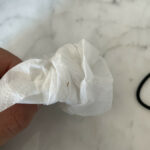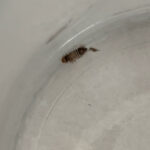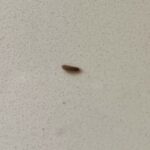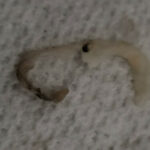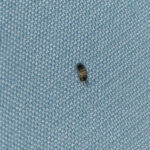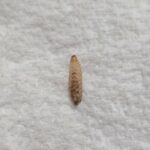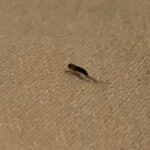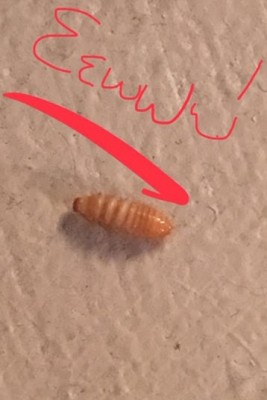
A woman recently contacted us with the following image of a bug she estimates to be about 1/4-inch or smaller. She found this creature on her couch, and from the picture we can see it is brown and tan striped in color, with a darker brown head at one of its ends.
Our reader says she freaked out when discovering this bug, and that she has never seen anything like it. She adds that her and her husband vacuum their NYC apartment every week and that they keep it clean. First and foremost, we wish to assure our reader that she has nothing to worry about in terms of the safety of her or her husband. We know was this is; it is a carpet beetle larva. This a common critter to find inside one’s household, and unfortunately even if one vacuums often, they have places they reside where one perhaps does not normally vacuum.
While vacuuming and consistent housekeeping usually does prevent bug infestations, it does not necessarily prevent the odd stray bug from wandering into one’s home, and given that our reader only found one of these larvae, we would assume that this is a case of one lost carpet beetle larva wandering into her home, and that she is not infested with carpet beetle larvae. Small, underdeveloped larvae like this one likely find their way into people’s home by means of travelling on something else; whether that’s on the pelt of another animal (like, a pet), or on a second-hand piece of upholstered furniture. That is not to say that infestations of carpet beetle larvae cannot happen, for they are very common, in fact. We also want to point that is it not impossible that our reader is actually infested with carpet beetle larvae, but has yet to discover them. Therefore, we will provide advice for both possibilities.
Carpet beetle larvae are, of course, the larval form of the carpet beetle. These larvae tend to be 4-5mm, so our reader is correct in saying that the larva she found might have been smaller than 1/4-inches (which is approximately 6.4mm). They range from brown and tan in color, to black and gray in color, and usually have bristles sticking out from their body, as well as a pronged tail at one end. This larva in particular seems to only just be developing that part of its body, so we would guess that it very underdeveloped, perhaps even newly hatched. These creatures are household pests, and get their name from their preferred diet, which is animal-based fabrics. It is actually in their larval stage that carpet beetles do most damage, so be sure to deal with them upon discovery! Besides carpets, these larvae feed on upholstery, clothing, and curtains. They can be found hiding in dark, secluded spaces where they can feed quietly on these different materials, thus, under upholstered furniture, between the folds of clothes and curtains, or inside closets. According to The University of Kentucky’s Entomology Department, carpet beetle larvae can even be found in places where there are other dead insects or animals, such as in the attic, in air vents, and in basements, where they like to produce. Of course, this is only relevant once the larvae have matured into adults, which takes approximately two to three weeks.
Furthermore, as our reader does not seem to be dealing with an infestation, simply removing the larva from her house should suffice in dealing with the worm. But to ensure it does not return, or that other creatures do not crawl in (as this one must have gotten in somehow), we encourage our reader to ensure that all the possible points of entry in her apartment (cracks in the baseboards, walls or floorboards, defective window screens, etc.) are sealed. However, if our reader has reasonable cause to believe that she is experiencing an infestation, which will be made obvious by a growing number of larvae found, or simply wants to be 100% positive that any other larvae are eradicated, then there are simple, but time consuming steps she can take to be rid of this problem.
The first step is locating the source of the larvae. If our reader searches in the locations previously listed, she will most likely succeed in this first step. What she is looking for is a tiny cluster of eggs. Once the source is located, vacuuming up the eggs should successfully rid her home of the larvae that resided there. Although our reader already stated that she does regularly vacuum, it is important to note that the source could be located in any of those aforementioned locations where one might not vacuum that often. Additionally, larvae that have already hatched and moved elsewhere may not be at the source, but off feeding on whatever fabric they have chosen. Thus, it is important to not only vacuum, but launder all animal-based fabrics one owns to ensure the removal of all larvae (this includes fabrics that are a mix of animal and synthetic materials).
In conclusion, the bug that our reader found was in fact a carpet beetle larva! These critters are pests, as they will eat through fabrics, and infestations can occur. Hence, we recommend dealing with these critters immediately upon discovery. If our reader wishes to learn more about carpet beetles, she may consult an article we recently wrote covering carpet beetle larvae that contains some different information she may find useful.
All About Worms is always free, always reader-supported. Your tips via CashApp, Venmo, or Paypal are appreciated! Receipts will come from ISIPP Publishing.
You might also find these guys interesting!





